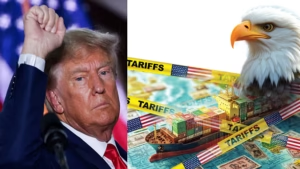US tariffs: Shrimp, medical equipment and gold jewelery will be more affected; Big opportunity for India in electronics

New Delhi| India’s export sector such as shrimp, carpets, medical equipment and gold jewellery will be hit by the 27% additional import duty announced by the US. However, export sectors like electronics, textiles and pharma will get an edge over their competitors in the US. This declaration includes a universal 10 per cent tariff on all imported goods, effective April 5. On 9 April, it will be reduced to 27 per cent.
The US is the largest market in the domestic shrimp industry. Shrimp will now become significantly less competitive on the US market due to higher tariffs. America has already imposed anti-dumping duty on Indian shrimp. Of India’s total shrimp exports, 40 per cent are exported to the US. Ecuador and Indonesia are the major competitors of domestic exporters in the US market.
Frozen shrimp exports during 2023-24 were 7,16,004 tones. The US imported 2,97,571 tons in the last fiscal year. Frozen shrimp remained the major commodity exported to the US. The US is the largest importer of Indian carpets and imported 17,000 crore in 2023-24.
Big opportunity for India in electronics
Countries like Vietnam and Thailand in the electronics, telecommunications and smartphone sectors are likely to lose cost competitiveness due to the US’s high tariffs. This opens up an opportunity for India, which has already started investing in electronics manufacturing through government incentives like the Production-Linked Incentive (PLI) scheme. Partial relocation of supply chains from Taiwan (32 per cent) due to tariffs could also benefit India, provided it has adequate infrastructure and policy support.
These sectors will benefit from tariffs
Agriculture, Pharma, Semiconductor, Copper, Oil, Gas and LNG
These sectors may be affected
Automobile and its components
No tariff on these
Pharma, semiconductor, copper and energy products such as oil, gas, coal and LNG.
IT: Wait Strategy
The IT sector is in no hurry on tariffs right now. The sector believes that a watch and wait strategy will have to be adopted for the next quarter to know this impact. The tariff order will not have a direct impact on the export-led Indian IT sector. The $250 billion Indian IT group derives a large portion of its revenue from serving U.S. customers.
Textiles: Promotion of new investments
High tariffs on Chinese and Bangladeshi exports are one of the key sectors for Indian textile manufacturers to gain market share, attract production and increase exports to the US. India’s strong base in textile production and low tariffs could boost global demand and new investment.
Exemption to pharma, but concerns about future drug exports
The pharmaceutical sector was exempted from the tariff. This has raised concerns about possible future restrictions on drug exports. Pharma products in future actions, HDFC Securities said, may be subject to duty under the Expansion of Trade Act, 1962. This Act empowers the US to impose new duties on imports.
India can maintain agricultural exports
Prominent agricultural economist Ashok Gulati said India could maintain or even expand its agricultural exports to the US as competing countries face even more stringent tariffs.
Better situation in rice
The US tariff on this is currently 9 per cent. India maintains a competitive edge against Vietnam and Thailand despite growth of up to 26 per cent. India exports between 250,000 and 300,000 tones of rice to the US annually.
Big blow to gems and jewellery sector
Counter duty is a major blow to Indian gems and jewellery exports. “In the long run, we see changes in global supply chains”, GJEPC said. In the short term we anticipate challenges in maintaining India’s current $10 billion exports to the US market. Import duty on open diamonds may increase from the current ‘0’ per cent to 20 per cent and on gold jewellery from 5.5-7 per cent. The U.S. imports $11.58 billion in gems and jewelry from India and exports $5.31 billion to India.
There will be more impact on machinery and auto sector
Sectors such as machinery, automobiles and toys, in which China and Thailand are currently leaders, are also vulnerable to tariff related transfers. Goods coming from India are already being subjected to a 25 per cent tariff on the steel, aluminum and auto sectors. India will become more sensitive to low-cost steel imports, as countries affected by the US move may divert their shipments to the domestic market. Countries facing US tariffs may start manufacturing in India.





